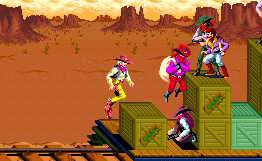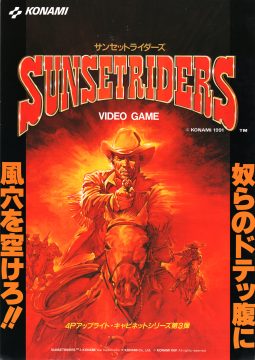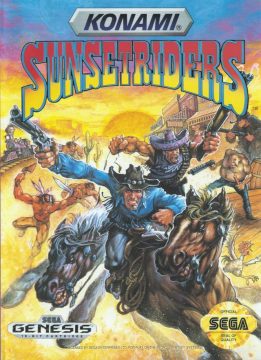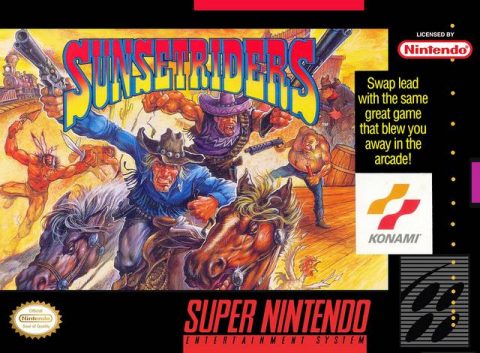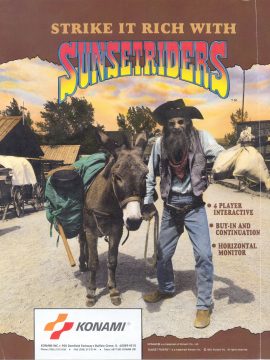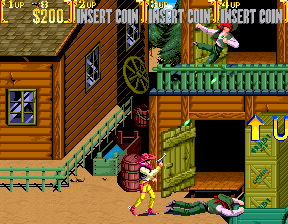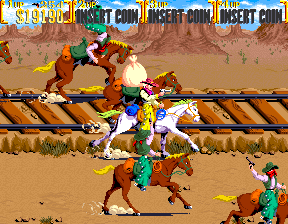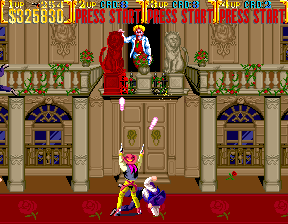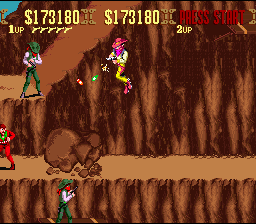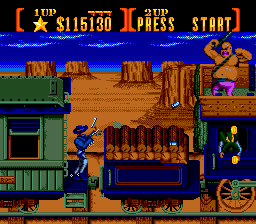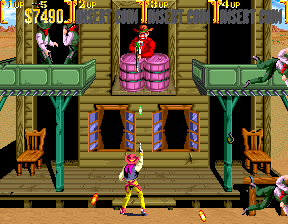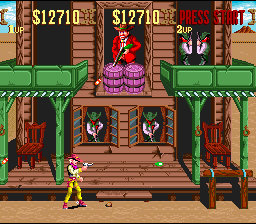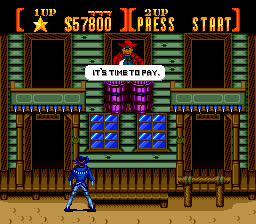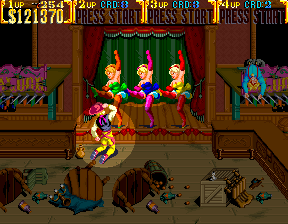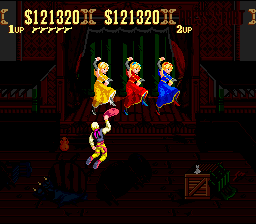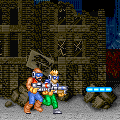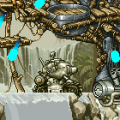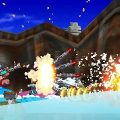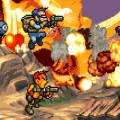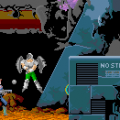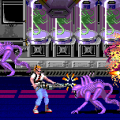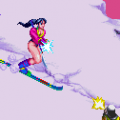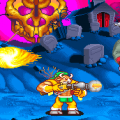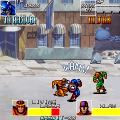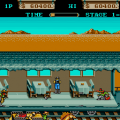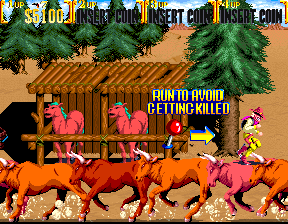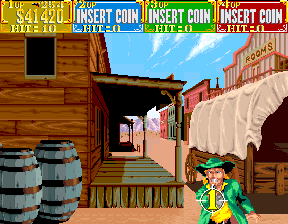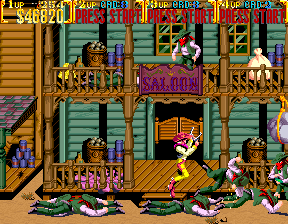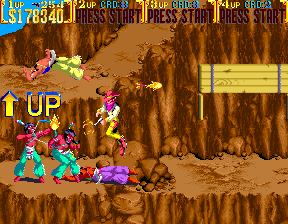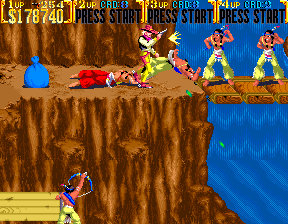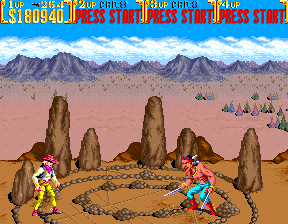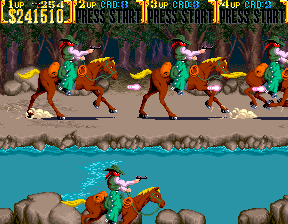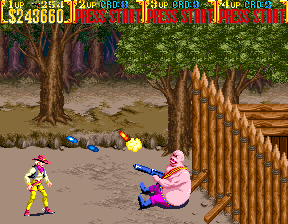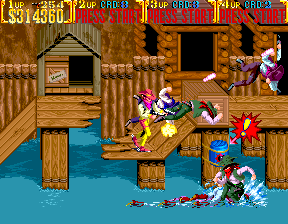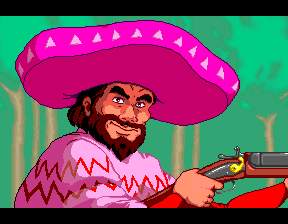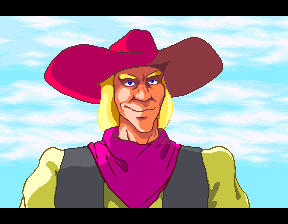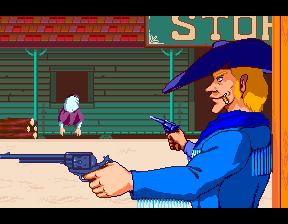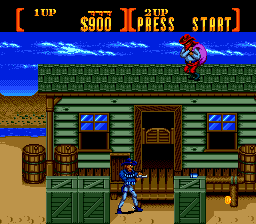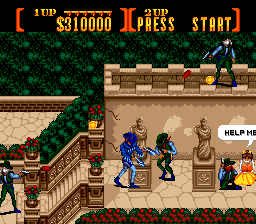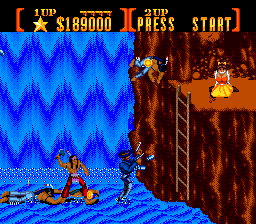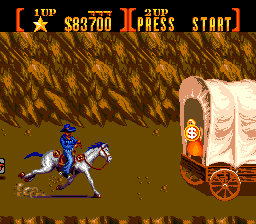In 1990, Konami was wiping up the arcade industry with its massively popular Teenage Mutant Ninja Turtles beat-em-up. The draw was more than just the license – it was also the four-player simultaneous action. With that in mind, Konami created Sunset Riders, a Wild West-themed run-and-gun. It expands upon the same formula as Surprise Attack (and by extension, Rolling Thunder and Shinobi) by having two-tiered stages you can jump between. There are even doors you can run into to get power-ups.
The major difference here is that you can shoot upwards, downwards, and even diagonally. This versatility, along with the looser controls and faster pace, makes the action feel a bit more like Contra. That game was crazy enough by itself, but it gets pretty chaotic when you have four players firing bullets at nearly half a dozen enemies coming out from all angles, especially since you die with a single hit. The four heroes each wield two types of weapons – Steve and Billy carry six-shooters while Bob and Cormano use shotguns, each with different firing configurations. There are items that increase the rapid-fire capabilities, too, or give you an extra weapon with a spread shot.
Each of the eight stages begins with a “WANTED” sign, showing off the boss of the level, each of whom has some unique distinction. Simon Greedwell is a rich tycoon that cries out “Bury me with my money!” Chief Scalpem is a Native American, whose sister protects him before you deliver the final blow, claiming “Please, please don’t shoot my brother! He’s only following orders!” To which your character replies “Okay ma’am. We won’t shoot him.” (Despite the fact that you spent the whole battle shooting at him, but let’s disregard that.) The final boss is a British gentleman named Sir Richard Rose, who fakes his death after several hits, removes a bulletproof plate from under his shirt, and proceeds to take more damage before dying for real, when he dramatically tosses his rose lapel aside. The whole thing is obviously very tongue-in-cheek, and adds a lot of personality.
There are lots of cool little features which fit in with the Old West theme. The first stage has you trying to avoid a stampede by running on the backs of bulls, a few other areas have you riding on horses. Running inside certain doors will grant you some whiskey for extra points, or “refreshments” (!!) from one of the town ladies. Some enemies will throw dynamite, which can be picked up and thrown back at them if you’re quick enough. The stages are also littered with barrels, boulders, and other bits of scenery that can be pushed and used to drop onto bad guys. There are also a few first-person shooting galleries that act as bonus stages, foreshadowing Konami’s western-themed light gun game Lethal Enforcers II: Gunfighters. One entire stage is a boss fight in a saloon, which ends with a can-can dance show. The fantastic soundtrack is appropriate to the Western theme and is full of the typical Konami energy.
Sunset Riders is an excellent game, and a fine alternative to the Contra series, especially for those who prefer the run-and-gun aspects of the earlier games.
As far as the ports go, the SNES version is remarkably faithful. The four-player functionality is gone, however. Most of the graphics have transitioned well, although some of the fancier effects, particular the sprite scaling, are absent. It’s quite a bit easier, too, with less going on at any given time. The music is almost perfectly replicated and most of the voice samples are in, now with subtitles so they’re easier to understand.
More interesting are the things that were censored. The female enemies – the ones that tossed dynamite in the arcade version – are now male. All references to alcohol are gone, too, and all of the girls now wear slightly more wholesome outfits. One of the levels in the arcade version consists entirely of Native American enemies. This was changed in the SNES version so they’re all regular bad guys, probably to avoid any of uncomfortable genocidal overtones. The end level boss, another Native American, remains mostly unchanged, although his name was changed from Chief Scalpem to Wigwam.
The Genesis version is so completely stripped down that it’s almost an entirely different game, and comes off poorly in comparison. There are only two playable characters, and a total of four stages. These include the town, train, mountain, and mansion areas. The layouts themselves are different and quite a bit longer, being divided into halves. In reconstructing the stages to use fewer background tiles, the designers introduced many more obstacles, which in turn makes it much harder than the original. When you run out of lives, you can continue right where you left off, like in the arcade version – this contrasts to the SNES port, which restarted you at the beginning of the stage. Enemies drop coins when you kill them, but conversely, you’ll also lose a chunk of change when you get killed. This is solely for scoring purposes, though.
The only remaining bosses are Simon Greedwell, Paco Loco, Chief Scalpem, and Sir Richard Rose. The graphics are heavily downgraded, with a solid black status bar at the top of the screen. The music also takes a hit, although it still sounds okay, but nearly all of the voices are gone, too. The bonus stages have been replaced with horse riding segments, where a girl tosses items from a covered wagon. There’s also a new two-player versus mode, for all the good that does. Much of the changes have to do with the ROM size being a meager 512 kb, which were typically only used in the early days of the Genesis. The much more faithful SNES port uses twice that amount of space.
